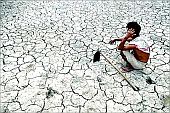 After a truant monsoon, in which the state recorded a 30 per cent deficit in rainfall, the Andhra Pradesh government on Wednesday declared 971 mandals (blocks) in 21 of the 23 districts as drought hit.
After a truant monsoon, in which the state recorded a 30 per cent deficit in rainfall, the Andhra Pradesh government on Wednesday declared 971 mandals (blocks) in 21 of the 23 districts as drought hit.
The much-awaited decision was announced by the Chief Minister Konijeti Rosaiah at a news conference on Wednesday.
"Late Chief Minister Y S Rajasekhara Reddy had planned to declare drought hit areas on September 4 but unfortunately he passed away and I am making this announcement," Rosaiah said.
The chief minister announced that he was seeking Rs 4000 crore assistance from the Centre for relief work in drought-hit areas.
No mandal in Srikakulam and Hyderabad districts find a place in the list because Srikakulam had recoded above normal rainfall and Hyderabad district does not have rural pockets.
"The mandals where drought has been declared had recorded 32 per cent deficit in rainfall," the chief minister said, adding that as part of the relief for farmers, input subsidy will be given for crops damaged 50 per cent or more due to drought.
Rosaiah said as part of the relief measures, the government will launch rural development works in the affected areas.
The state government's announcement comes even as the situation has been showing signs of improvement with heavy rains lashing different parts of the state in the last two weeks.
After taking over as chief minister, Rosaiah put seasonal conditions as his topmost agenda and held regular reviews to monitor the situation.
Earlier, at an official meeting, Rosaiah noted that of the Rs 14,000 crore crop loans target, banks had already distributed 80 per cent or an amount of Rs 11,200 crore.
An indication of the severity of drought condition was available from the fact that against the normal area of kharif season crop over 79.07 lakh hectare, sowing was done only on an area of 53.81 lakh hectare (68 per cent).
In view of the dry conditions, the government has been encouraging farmers to take up alternate crops like pulses, castor, sunflower, horsegram and cowpea in place of water intensive crops like paddy, sugarcane, cotton and other commercial crops.
Meanwhile, recent rains in areas bordering Maharashtra and Karnataka helped improve the water level in two major reservoirs of Srisailam and Nagarjuna Sagar on river Krishna.
With the inflows in to Srisailam project from upper areas increasing and level reaching 881.40 feet, the authorities have started hydel generation plants to the full capacity. The reservoir has now 243.2619 tmc ft of water and there were indications that the water will be released from the project for irrigation. Another 25 tmc ft of water will be sufficient to fill the reservoir to its capacity.
Similarly, the water level in Nagarjuna Sagar has reached 510 feet and the hydel power generation has started on this project as well, easing the power situation in the state to a large extent.
With both the major projects brimming with water and a total of 350 tmc ft of water being available, officials said that there will be no problem of drinking water in state capital Hyderabad and surrounding areas, and villages in Nalgonda, Krishna, Guntur and Prakasham district till next summer.
Water will also be released in to Telugu Ganga canal, which supplies drinking water to Chennai. Orders have been issued to release 5 tmc ft of water to Chennai.







